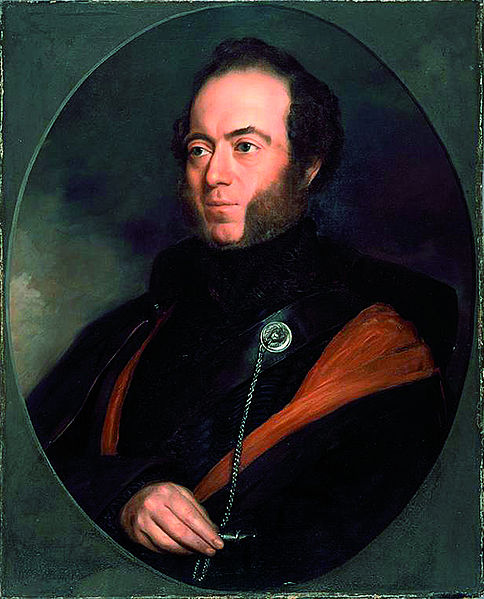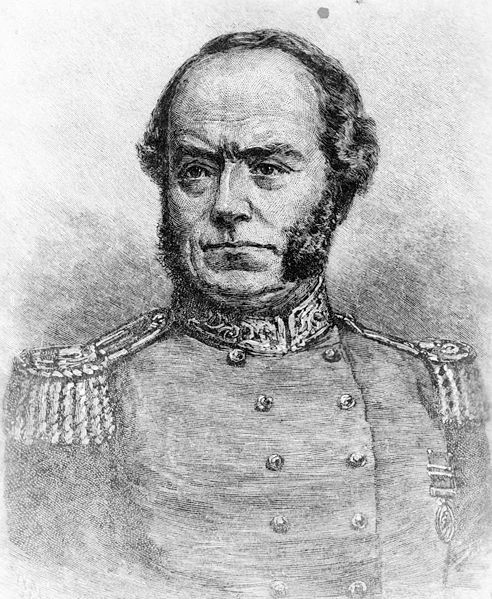<Back to Index>
- Explorer Thomas Livingstone Mitchell, 1792
- Poet William Wilfred Campbell, 1860
- 7th President of Israel Ezer Weizman, 1924
PAGE SPONSOR


Major Sir Thomas Livingstone Mitchell (15 June 1792 – 5 October 1855), surveyor and explorer of south - eastern Australia, was born at Grangemouth in Stirlingshire, Scotland. In 1827 he took up an appointment as Assistant Surveyor General of New South Wales. The following year he became Surveyor General and remained in this position until his death. Mitchell was knighted in 1838 for his contribution to the surveying of Australia.
Mitchell was educated at the University of Edinburgh, but the poverty of his family following his father's death led him to join the Army in 1811. He saw service in Portugal, where Sir George Murray, later to be Colonial Secretary, was the Army's Quartermaster - General, and became Mitchell's most important connection. He learned surveying in the Army, and in 1817 he married Mary Blunt in Lisbon. When the Napoleonic Wars ended in 1815, Mitchell returned to peacetime soldiering.
In 1827, with Murray's support, Mitchell became Assistant Surveyor General of New South Wales with the right to succeed John Oxley. When Oxley died in 1828, Mitchell became Surveyor General. In this post he did much to improve the quality and accuracy of surveying - a vital task in a colony where huge tracts of land were being opened up and sold to new settlers. One of the first roads surveyed under his leadership was the Great North Road, built by convict labor between 1826 and 1836 linking Sydney to the Hunter Valley. The Great South Road, also convict - built, linked Sydney and Goulburn.In 1834 he was commissioned to survey a map of the Nineteen Counties. The map he produced was done with such skill and accuracy that he was awarded a knighthood.
In 1831, George Clarke who had lived in the area for several years claimed that a river that the Aborigines called Kindur flowed north - west from Liverpool ranges in New South Wales to the sea. Charles Sturt said that the Murray - Darling system formed the main river system of New South Wales and Mitchell wanted to prove Sturt wrong. Mitchell then set off on 24 November 1831 to find the Kindur River. In his party was 2 surveyors, 15 convicts and his personal servant, James Marsh who came with him on every expedition. Between 30 November and 11 December he got to Wallamoul Station near Tamworth. Mitchell used 20 bullocks, three heavy drays, three light carts and 9 horses. Most of the time the animals were used as pack animals. A little while later an Aborigine named Mr Brown joined his party and led them into unexplored territory. Mitchell found a deep, broad river but it was not the Kinder it was the Gwydir. On 21 January Mitchell split his team One group followed the Gwydir River but Mitchell's group headed north. Two days later Mitchell found a large river and then sent for the other half of the party and began to build a wooden boat. Meanwhile Mitchell explored the river from land but he eventually decided it was the Darling River, with no need for exploration on water. The person who was meant to bring supplies arrived but without supplies because Aborigines had killed two out of the three of his men. Mitchell then had no choice but to call off the expedition and go home.
Mitchell's next expedition was on 7 April 1835. This expedition was put together to trace the course of the Darling River to the sea. In his party, there was an assistant surveyor, James Larmer, botanist, Richard Cunningham, Mitchell's personal servant and 20 other men. After the murder of botanist, Richard Cunningham, who was killed by Aborigines while he was by the Darling River, Mitchell decided to continue his expedition. They then followed the Bogan River downstream led by an Aborigine. Mitchell decided to explore the Darling River with two boats they had lugged all the way there with them but is as it was shallow they continued over land. After one month of following the river, Mitchell believed that it was the Darling and didn't want to continue. He came back on 14 September the same year. His expedition had achieved very little because he didn't trace the Darling River to the sea.
Expedition 3 started on 18 March 1836. Mitchell was instructed once again to follow the Darling River to its end. In his party there was 25 men including his personal servant. At one point Mitchell decided to take a small group west. He found no other rivers so he decided to turn back to camp. On 23 May, he reached the Murray River. His camp was attacked three times by Aborigines. They came across 200 Aborigines who they thought were going to attack. Mitchell's men started to shoot at them and killed seven. He continued to explore and then decided that Sturt was right that the Darling did flow into the Murray River. He was determined to leave the Darling and explore the Murray River. While he was exploring the Murray, Thomas Mitchell decided that the area to the south east looked interesting so he began to explore it. That's how he discovered the Grampians. They then found a river that Mitchell called Glenelg, which Mitchell chose to follow and it led to the sea. They returned to their camp and continued to explore the coast line. They soon discovered the Henty brothers' farm, who were the first permanent settlers in this area. They gave Mitchell supplies and Mitchell headed for home. He returned to Sydney and was happy that he had discovered a vast, fertile region which would undoubtedly ensure his fame as an explorer.
His fourth expedition was into Queensland in 1845 - 46. In 1837, Mitchell sought 18 months leave from his position and in May he left Sydney for London. During his leave, he published an account of his explorations called Three
Expeditions Into the Interior of Eastern Australia: with descriptions
of the recently explored region of Australia Felix, and of the present
colony of New South Wales. Mitchell sought additional periods of
leave and finally arrived back in Australia in 1841. Mitchell left
Sydney again in March 1847 on another period of leave. By the time he
arrived back in mid 1848, he had published his Journal of an Expedition into the Interior of Tropical Australia, in search of a route from Sydney to the Gulf of Carpentaria. Mitchell's
journals proved a rich source for historians and anthropologists, with
their close and sympathetic observations of the Aboriginal peoples he
had encountered. These publications made him the most celebrated
Australian explorer of his day. But he was a famously difficult man to
get on with, made evident by this passage made by Governor Charles Augustus FitzRoy: "It
is notorious that Sir Thomas Mitchell's unfortunate impracticability of
temper and spirit of opposition of those in authority over him misled
him into frequent collision with my predecessors." In
a by-election in April 1844, Mitchell was elected to the New South
Wales Legislative Council. He found it difficult to separate his roles
of government employee and elected member of the legislature, and after
only five months he resigned from the Legislative Council. Mitchell
is also remembered as the last person in Australia to challenge anyone
to a duel. In September 1851, Mitchell issued a challenge to Sir Stuart
Alexander Donaldson because Donaldson had publicly criticised excessive
spending by the Surveyor General’s Department. The duel took place in
Sydney on 27 September with both duellists missing their marks. The French 50 calibre pistols used in the duel are in the collection of the National Museum of Australia. In July 1855 a Royal Commission was
appointed to inquire into the New South Wales Survey Department. Before
its report was published, Mitchell contracted a chill while surveying
the line of road between Nelligen and Braidwood. He developed pneumonia and died in Sydney in October 1855. A newspaper of the day commented: "For
a period of twenty - eight years Sir Thomas Mitchell had served the
Colony, much of that service having been exceedingly arduous and
difficult. Among the early explorers of Australia his name will occupy
an honoured place in the estimation of posterity." He is buried at Camperdown Cemetery, Newtown, with his grave being maintained by the Seniors Group of Surveyors.
Some of the places Mitchell named on his expeditions were: the Avoca River, Balonne River, Belyando River, Campaspe River, Cogoon River, Discovery Bay, Glenelg River, Grampians, Maranoa River, Mount Arapiles, Mount King, Mount Macedon, Mount Napier, Mount William, Nyngan, Pyramid Hills, St George, Swan Hill and Wimmera River.
Among other ways, Mitchell is commemorated by the town of Mitchell in Queensland, the Canberra suburb of Mitchell, the electorate of Mitchell, and in the name of Mitchell College in Wodonga, Victoria. The Major Mitchell's Cockatoo is named in his honour, as well as Mitchell's Hopping Mouse, Mitchell Falls, Mitchell Highway, Mitchell Park, Mitchell Plateau, Mitchell's Lookout, Mitchell River, Sir Thomas Mitchell Road in Bondi Beach, and Sir Thomas Mitchell Drive in Davidson, Sydney. A Victorian Railways S class locomotive
was named after Mitchell. Mitchell is also the namesake in the highest
honour of the New South Wales Surveyors Awards, the Sir Thomas Mitchell Excellence in Surveying Award.